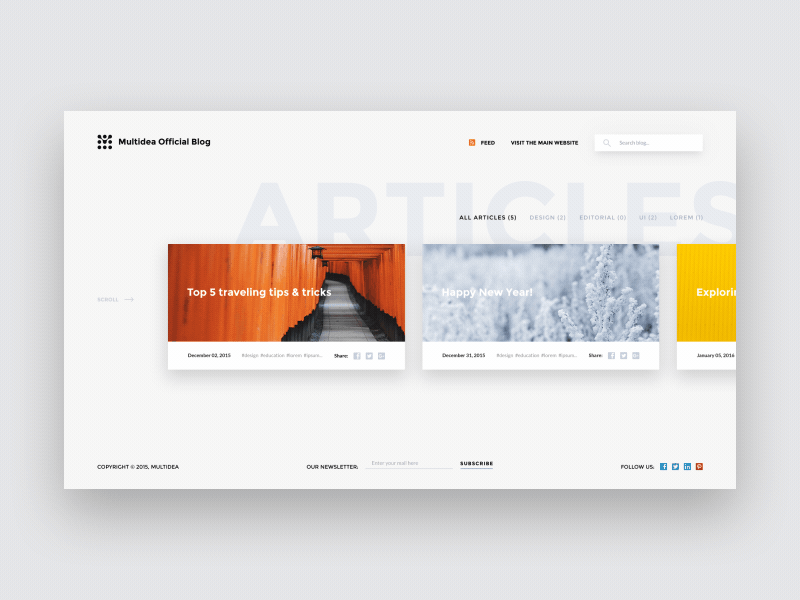Kentico is an all-in-one CMS,
E-commerce,
and Online Marketing platform developed with ASP.NET and MS SQL. From
developers to content editors, it’s easy to use and allows users to make
edits and update the system quickly, enabling companies to operate both
more efficiently and effectively. The beauty of Kentico is that it’s
loaded with features such as WYSIWYG editor, workflow, permissions,
multilingual support, full-text search, online forms, newsletters,
e-commerce, blogs, polls, web analytics and other modules.
There are three basic development models provided by Kentico.
- Portal Engine:
Provides you with a browser-based interface using web parts components
to create websites. Coding with the Visual studio is only required while
creating custom components.
- ASPX templates: The
developers can find varied templates to suit the website needs and this
can be further customized using standard ASP.NET architecture and
standard development tools, such as Visual Studio. This
model requires you to be familiar with ASP.NET web form development and
have at least basic programming knowledge of C# or VB.NET.
- MVC: Kentico allows
you to create websites using the Model-View-Controller architectural
pattern (based on the ASP.NET MVC framework). Note that, not all
features are supported for MVC development; see Supported and unsupported Kentico features on MVC sites for more details.
Why Kentico?
1. Ease of Use
Kentico CMS is out of the box one of the
easiest CMS systems to use. Anyone who has ever used the Internet has
all the skills required to add and update pages, add dynamic content,
and create stunning, feature-rich websites. Kentico administration
system comes with plenty of tips and descriptions to guide users through
nearly every process. Additionally, Kentico provides step-by-step
guides and tutorials directly on their site along with videos, blogs,
and forums.
2. UI Personalization
The Kentico Administration site provides
the feature of UI personalization. The UI personalization application
enables you to provide certain users of the website with a simplified
user interface. This is useful for business users who don’t need to see
all the applications, tabs, menu items, or parts of UI pages which they
do not use. Setting up a personalized UI can significantly decrease the
learning time for users, new to the system and makes the system
generally easier to use and understand.
Note:
- UI personalization does not apply to users who have the Administrator Global administrator privilege level. Administrators always have access to all UI elements, regardless of the system’s UI personalization settings.
- Do not confuse UI personalization with
the permission system in Kentico. Permissions control what users can do,
such as create or modify objects, while UI personalization controls
what users can see. A user may be able to see a part of the UI but still
not have permissions to perform any actions.
3. Content Staging / Continuous Integration
One of the challenges of updating
content on a site is the repeated effort to migrate changes from one
platform to the next. Often companies will have different environments
for their staging (QA) content and their production (live) content. With
Kentico, publishing data from one environment to the next is
accomplished easily through the use of “content staging”. With a few
clicks, a user can migrate content between the systems and quickly
synchronize all environments. With the use of the “Scheduled Tasks”
feature, this process can even be accomplished on a daily or hourly
basis to increase productivity even further. This minimizes
administrative time and easily allows a company to define a concise
process for updates and deployments.
4. Workflows
Workflows in Kentico allow content to be
moved through a set of predefined steps. These steps are easily created
and configured in the Kentico system and can be quickly applied to any
or all content. An editor can make changes to a page, and then submit it
for approval. The approving manager gets notified automatically by the
Kentico system of the change. The managers can then view the edits,
submit them back to the editor for correction, publish the changes, or
even edit the edited content. Workflows can also be configured to have
several steps that must be completed before content is published to the
site.
5. Smart Search
Smart Search in Kentico is a
Lucene-based search functionality that quickly analyzes and locates
content. Through the use of this module, defined content is indexed and
stored in the system to allow searches to be completed much quicker than
traditional database-based methods. Search results can be customized to
only return relevant content and images. The Kentico system constantly
updates the search results as new website content changes to keep the
results accurate.
6. Feature-rich CMS
Off the shelf, the Kentico CMS system
allows for eCommerce, blogging, forums, messaging, and a number of other
critical functions. With the Ultimate license, companies have full
access to every feature and can quickly add new functionality to their
sites. Many other CMS systems require a series of add-ons to obtain the
functionality readily available in Kentico. Even if a company decides to
add modules, later on, all that is required is a simple update of the
license and the features for the module are unlocked. Having such a wide
range of features allows a company to focus on their business, not
piecing together functionality.
7. Smooth Updates
Kentico provides step-by-step guides for
every product update. Their installation packages are professionally
written and provide a solid, concise process for applying the updated
content. Any special requirements are clearly defined and easy to
follow. Updates come complete with documentation and files targeted at a
number of environments (.NET 2.0,3.5,etc.) so that all clients can
benefit from their improvements.
8. Customer Recognition
Kentico is constantly gaining market share and quickly becoming a premier
CMS software company.
Kentico constantly communicates upcoming changes with their clients and
values their input. Kentico listens to its partners and strives to
deliver a product that meets their needs. For the training program,
Kentico reached out to several of their “Gold” level partners to create
the training material and guidelines. This type of customer involvement
demonstrates Kentico’s commitment to their clients and their success.
9. Constantly Evolving
As each day passes, new technologies and
functionality are being created. The folks at Kentico embrace these
changes and are constantly incorporating them into their product. They
test their code using the latest development environments and servers
(Visual Studio 2010/Windows Server 2008) to ensure compliance. Kentico
integrates a number of third-party components (CKEditor, Lucene, AJAX,
etc.) and utilizes the latest source code that is available. All of
these efforts allow Kentico to deliver the latest technologies and
functionality that drive dynamic, interactive websites.
10. New Documentation
With the release of each new version of
Kentico, it keeps on adding a lot of developer-centric functionality.
With this, there comes a lot of questions from the community on how to
utilize them and best practices. With the release of each new version of
Kentico, they also keep updating their documentation to provide the
information to get developers heading in the right direction. It really
helps the developers to understand the new features and help them
implement within the applications.
References
- https://docs.kentico.com/k9tutorial/site-development-overview
- https://docs.kentico.com/k9/managing-users/ui-personalization
- https://devnet.kentico.com/articles/five-things-developers-should-be-excited-about-in-kentico-9
- https://bitwizards.com/Thought-Leadership/Blog/2010/May-2010/Top-10-reasons-to-use-Kentico-CMS
 Buried Treasure Fossil is the place for new and seasoned fossil collectors, providing a wide range of incredible fossils to choose from. As a purely online business, BTF strategy is to offer great fossils at great prices, and super service for customers across the USA. The relatively young company is owned by Gary Greaser, an avid enthusiast, and collector of the fossils. Having realized that migrating to Magento Opensource from Magento 1.7 could enable him to boost his sales while delivering an excellent customer experience, Gary chose Sigma to migrate their site to Magento Opensource which was completed and went live in 4 months.
Buried Treasure Fossil is the place for new and seasoned fossil collectors, providing a wide range of incredible fossils to choose from. As a purely online business, BTF strategy is to offer great fossils at great prices, and super service for customers across the USA. The relatively young company is owned by Gary Greaser, an avid enthusiast, and collector of the fossils. Having realized that migrating to Magento Opensource from Magento 1.7 could enable him to boost his sales while delivering an excellent customer experience, Gary chose Sigma to migrate their site to Magento Opensource which was completed and went live in 4 months.







 Modals that are controlled typically with a script and overlaid as a cover over the page’s elements has been an effective user interface medium for quite some time. The only change that has modified the trend is that these models are now full-screen so that both the mobile and computer
Modals that are controlled typically with a script and overlaid as a cover over the page’s elements has been an effective user interface medium for quite some time. The only change that has modified the trend is that these models are now full-screen so that both the mobile and computer  These two features are forming the face of most e-commerce
These two features are forming the face of most e-commerce 
